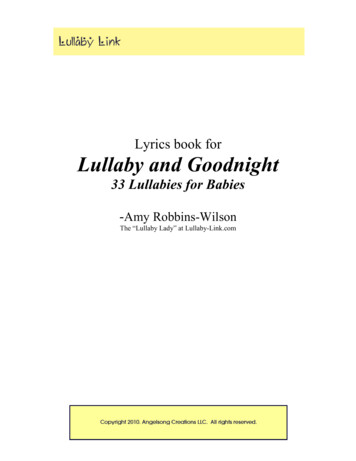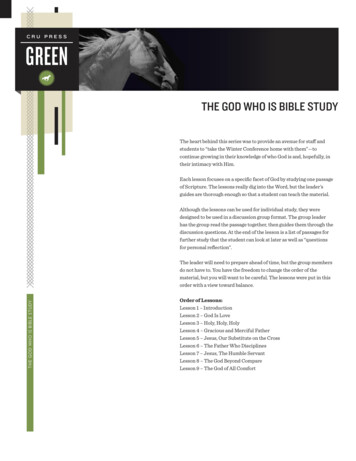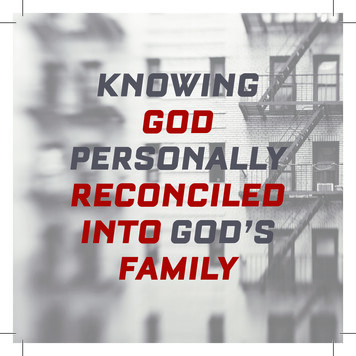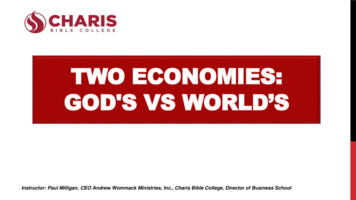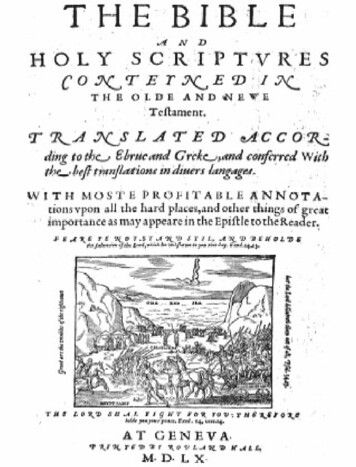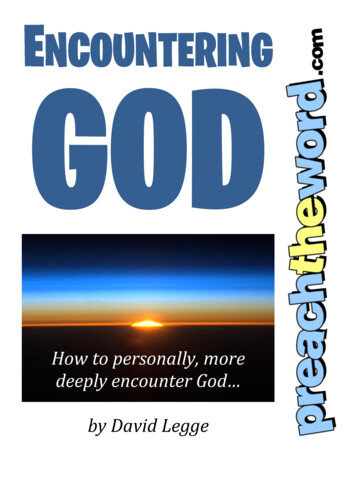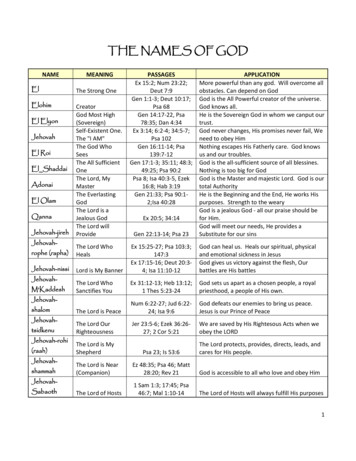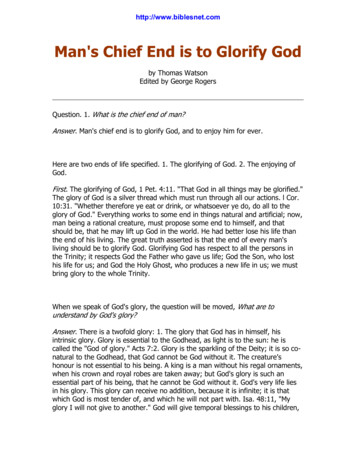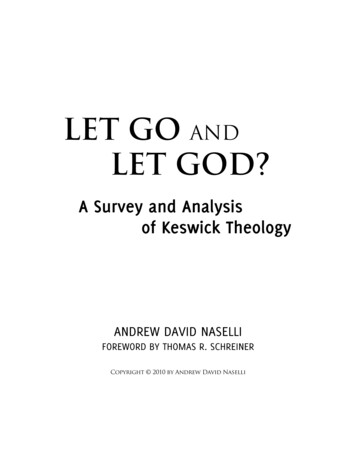
Transcription
LET GO ANDLET GOD?A Survey and Analysisof Keswick TheologyANDREW DAVID NASELLIFOREWORD BY THOMAS R. SCHREINERCopyright 2010 by Andrew David Naselli
This book packs an extraordinary amount of useful summary, critical analysis,and pastoral reflection into short compass. One does not have to agree with everyopinion to recognize that this is a comprehensive and penetrating analysis ofKeswick theology down to 1920. The book will do the most good, however, if itencourages readers in a more faithful way to pursue that holiness without whichwe will not see the Lord (Hebrews 12:14).D. A. CarsonResearch Professor of New TestamentTrinity Evangelical Divinity SchoolDeerfield, IllinoisFor years popular Christian teachers have been telling us the secret key to thevictorious, higher, deeper, more abundant Christian life. We’ve been told just to“let go and let God.” If you’ve heard that teaching, you’ll want to read thisbook—the definitive history and critique of second-blessing theology. You’lllearn not only where this theology went wrong, but will also discover afresh thewell-worn old paths of biblical faithfulness and holiness. Andy Naselli is anextraordinarily careful scholar who leaves no stone unturned, but also acompassionate guide who longs to help and serve the church of Jesus Christ.Readers of this work will be instructed and encouraged in their Christian walk.Justin TaylorVice President of Editorial; Managing editor, ESV Study BibleCrosswayBlogger at Between Two WorldsWheaton, Illinois
Keswick theology cast a wide and long shadow over twentieth-century church lifein America. Curiously, though, it never received a sustained, thorough analysis.Until now, that is. Andy Naselli has filled in the gap, doing us all a favor byimmersing himself in the literature and the ethos of the movement. The result isan even-handed and substantial critique.Keswick theology, especially in terms of its telltale doctrine of “victoriousliving,” strikes me as falling under the category of seeming like a good idea at thetime that then quickly veered down a rocky road. Sadly, many have been left in itswake of deferred dreams of the victorious life. Dr. Naselli’s book offers greatinsight into what went wrong, and even guidance on how to get back on track.Stephen J. NicholsResearch Professor of Christianity and CultureLancaster Bible CollegeLancaster, PennsylvaniaAs a pastor, I don’t get asked to read many dissertations. I can’t say I was piningfor more. I have enough to read without having to slog through a bazillionfootnotes on the role of dyslexic cobblers on the development of pre-industrialFrench mercantilism. But alas, my suspicions of nascent scholarship were born ofignorance. At least Andy Naselli proved them wrong in a big way on thisoccasion. Andy’s work on Keswick theology is first-rate. I knew it would be. ButI didn’t know it would be so interesting . . . and edifying . . . and applicable . . .and easy to read. This is a model of scholarship serving the church. I’ve alreadyincorporated his analysis of Keswick’s history and his tight theological work onsanctification into my preaching. I enjoyed this book. I learned from this book. Iwas able to help my congregation by reading this book. I couldn’t ask for morefrom a few hundred pages and a few thousand footnotes.Kevin DeYoungSenior Pastor at University Reformed Church (RCA)East Lansing, Michigan
Andy Naselli’s thorough description and careful analysis of Keswick theologymakes a major contribution to contemporary evangelical theology and to theChristian doctrine of sanctification, more broadly. Like many others, I was earlyinfluenced by Keswick theology through books and teachers in the Keswicktradition. While I came to appreciate their stress on Christ’s ability, by His Spirit,to enable faithful Christian living, their “let go, let God” methodology is bothunbiblical and deeply misleading as a means of sanctification. I wish thatNaselli’s excellent study had been available when I struggled with these issues.And so now, I gladly commend this book to all sincere Christians who can bothlearn from the excesses of the Keswick model while also coming to see moreclearly and rightly the Bible’s pathway of progressive growth in sanctification.Bruce A. WareProfessor of Christian TheologyThe Southern Baptist Theological SeminaryHoliness movements are part and parcel of the church in every age. In theiremphasis on the need for Christianity to make a difference, they represent animportant biblical emphasis; but in their detachment from a biblical anthropology,they often tend inevitably towards legalism, lack of assurance, and, worst of all,self-righteousness. In this work, Andy Naselli subjects one of the most influentialof modern holiness movements to vigorous, but fair-minded, analysis. In sodoing, he makes an important contribution not just to church history but also forall those who seek to address the relevant issues in an informed and thoughtfulmanner.Carl TruemanAcademic Dean, Vice President of Academic Affairs, and Professor ofHistorical Theology and Church HistoryWestminster Theological SeminaryPhiladelphia, Pennsylvania
Forty years ago, as a brand new Christian, I devoured Keswick theology, whichhad great appeal to me as a vibrant and dynamic faith. I wrote “Let go and letGod” inside my Bible. But the more I studied Scripture and looked at my ownlife, the more I saw that much of this theology didn’t ring true. As a formerinsider, I found Andy Naselli’s critique to be fair, accurate, theologically sound,and biblically persuasive. Andy’s book offers the bonus of serving as an insightfulstudy of the doctrine of sanctification. I highly recommend it.Randy AlcornFounder and Director of Eternal Perspective MinistriesSandy, OregonEvangelical churches in the English-speaking world have worked hard in recentdecades to reflect the styles and moods of our time. But with fixation on thepresent can come amnesia about the past. A pity—because to a great degree ourpast defines and can entrap us. Yet knowledge of the past can also liberate. Herelies the service of this wonderfully organized, concise, and insightful study. Itclarifies core aspects of the Christian identity of most “evangelical” groups in theworld today as they have morphed and expanded over the past two centuries. Ityields invaluable biblical, theological, and self-understanding regarding howChristians claim to grow in faith—what “sanctification” is. It questions Keswickviews without disparaging them and commends alternatives withoutoversimplification. We are in the author’s debt for this irenic and ultimatelyconstructive breakdown of a debate that has shaped us all.Robert W. YarbroughProfessor of New Testament and Department ChairTrinity Evangelical Divinity SchoolDeerfield, Illinois
The history presented in this book is fascinating, and Andy Naselli is a gentle butfirm guide away from pitfalls and precipices to straight and narrow exegetical andtheological paths.James M. Hamilton Jr.Associate Professor of Biblical TheologyThe Southern Baptist Theological SeminaryLouisville, KentuckyI highly recommend the work on the history and theology of the Keswickmovement by Dr. Naselli. This study reveals the wide influence of the Keswickviews and practices of sanctification. Naselli’s research on the early history bringsout the great variety of perspectives that shared a common approach tosanctification. The pervasiveness of the Keswick influence gained a canonicalstatus in many circles. It may have been a powerful ideological movement, but itsadherents often experienced disappointment in their own experience. ManyChristians have been inspired by the movement, but have also become exhaustedby it. This book explains the strong emotions associated with the movement, bothpositive and negative.Willem A. VanGemerenProfessor of Old TestamentTrinity Evangelical Divinity SchoolDeerfield, IllinoisUnderstanding what the Bible teaches about sanctification is extremely important,but the abundance of paradigms and systems makes that task more complex thanit might seem at first. If we grew up in the church, we carry assumptions inheritedfrom our youth that shape our perspective on both life and the biblical texts. Thesongs we’ve sung, the verses we’ve heard quoted in testimonies and sermons, andthe path of our own Christian growth have all shaped the way we think and talkabout the Christian life. The assumptions about sanctification on which many
evangelicals and fundamentalists stand are most often inherited from Keswickteachings.That’s why I believe this book by Andy Naselli is so important. It providesvery valuable help in understanding the nature and impact of Keswick teaching.This is an evenhanded critique that does a wonderful job of putting together athorough explanation of both the various strands and unifying features of Keswickteaching. Naselli doesn’t go after straw men. He demonstrates that he has heardand understood before he critiques.Theology shapes ministry, so any book that helps me, as a pastor, to thinkmore clearly is a great blessing from God. That’s the kind of book this is. Take upand read!David M. DoranSenior Pastor, President, and Professor of Pastoral TheologyInterCity Baptist Church and Detroit Baptist Theological SeminaryAllen Park, MichiganThroughout the world and in every corner of Christendom, people are searchingdesperately for the higher life, the deeper life, and their best life now. Theappealing nineteenth-century theology associated with the Keswick movement isalive and well in the twenty-first century and is astonishingly prevalent in manyevangelical and Reformed churches. This insightful and scholarly work by AndyNaselli is well suited for professors and pastors, as well as for the concernedlayperson. Naselli provides a gracious and thorough assessment of variousaberrant views of sanctification while offering reasoned, biblical exegeticalconclusions on this most vital and difficult doctrine. This is the sort of practicalscholarship that the church most desperately needs.Burk ParsonsAssociate Minister, Saint Andrew’sEditor, Tabletalk magazineOrlando, Florida
Critiquing Keswick theology requires charitable prudence. On the one hand, itwould be painful, perhaps even presumptuous to appear to critique many of thebeloved figures in Church history who have testified so fervently to its blessedalteration of their lives and service. On the other hand, even the most cherishedbeliefs must be scrutinized objectively. Those found to be imbalanced orerroneous should be exposed scripturally.Andy Naselli avoids unnecessarily demeaning Keswick’s followers. Buthe lays bare the mistaken emphases that have resulted in the delusion and despairof many frustrated Christians. His work is factual, fair, and liberating from thewell-intentioned but futile pursuit of a crisis-sanctification.Mark MinnickSenior Pastor and Professor of New TestamentMount Calvary Baptist Church and Bob Jones UniversityGreenville, South CarolinaDr. Naselli’s work Let Go and Let God provides a fascinating account andperceptive critique of early Keswick—a movement that has had widespreadinfluence on conservative Christianity. The potentially deleterious impact of theseideas is more clearly seen in the historical and theological context that Nasellidescribes, especially the heterodox strains of some early leaders such as Palmerand Finney. Not just an historical tool, but a valuable insight for those whoshepherd God’s people, this book will prove a useful resource for both pastor andtheologian.Rodney J. DeckerProfessor of New TestamentBaptist Bible SeminaryClark Summit, PennsylvaniaNTresources.com
This is a book that every evangelical Christian should read because it addressesthe widespread belief that there is a chronological separation between thebeliever’s justification and sanctification, which results in two categories orclasses of Christians, the “carnal” and the “spiritual.” Naselli gives fifteentheological critiques of such Keswick theology, arguing that it is not heresy but itis “dangerously erroneous.” Along the way he gives a historical survey of theKeswick movement and addresses several topics of extreme importance for theChristian life, including perfectionism, free will, Spirit-filling, abiding in Christ,and false assurance. The charts and thorough bibliography add to the book’susefulness and value.W. Edward GlennyProfessor of New Testament and GreekNorthwestern CollegeSt. Paul, MinnesotaFew theological movements in twentieth-century American Protestantism enjoyedas broad an acceptance as Keswick theology. Proponents included such diversegroups as Baptists and Anglicans, Presbyterians and Pentecostals. Still todaymany Christians speak much of “surrender,” “dedication,” and “the victoriousChristian life.” These people may not even know how to pronounce Keswick, yetKeswick’s influence on their thinking is unmistakable. Let Go and Let God?serves pastors and parishoners alike by unfolding the history of the Keswickmovement and articulating the views of the well-intentioned (though oftenmisguided) early proponents. What readers will find most helpful is the author’scareful Scriptural analysis of Keswick theology. Andy Naselli’s work will helpbelievers identify Keswick’s problems, recognize where it crops up today, andthink more biblically about their sanctification.Matthew C. HoskinsonSenior PastorThe First Baptist Church in the City of New York
The godly man is a diligent man, but he is also a man profoundly conscious thateven his energy and diligence (let alone his gifts) are directly traceable to thegrace of God at work in him. That was Paul’s self-analysis in 1 Corinthians 15:10.For as long as I have known him, Andy Naselli has exemplified the reality of thatpassage, particularly in his research and writing ethic. His treatment of Keswicktheology is some of the fruit of God’s laboring grace in him.The Christian’s secret to a happy life is learning to interpret his experiencethrough the lens of revelation (consistently contextualized), rather thaninterpreting Scripture through the lens of personal experience. Throughout thehistory of the church, this struggle with perspective has manifested itself in bothdoctrinal and devotional arenas, and on the personal as well as the ecclesiasticallevel. One area that has both doctrinal and devotional, ecclesiastical and personal,ramifications is the issue of sanctification. A biblically conditioned perspective onthis subject has far-reaching implications for all believers individually, for thelocal assemblies of which they are a part, for the church of Christ in the earth and,consequently, for the glory of God. Andy Naselli’s excellent analysis of Keswicktheology in the area of sanctification is a perspective-correcting contribution thatis at once charitable and candid, fair and insightful, thorough and concise,accessible and theologically precise. It was a privilege to serve on the doctoralcommittee overseeing its original production as a dissertation, and a privilege nowto commend it warmly to a wider audience.Layton TalbertProfessor of Theology and ExpositionBob Jones University and SeminaryGreenville, South CarolinaDr Naselli’s study of ‘Early Keswick Theology’ combines careful historical,theological, and exegetical analysis and judgment to provide an important studyof this hugely influential movement. Carefully nuanced so as to distinguish theearlier movement from the more recent character of these annual events, thisstudy introduces famous figures such as Hudson Taylor, Handley Moule, Andrew
Murray, and Amy Carmichael, and helpfully describes the contours of thetheology of this movement. While appreciating its strengths, Dr Naselli presents acompelling argument that Keswick doctrine does not stand up to the scrutiny ofScripture at critical points. Many Christians have wrestled painfully with theirspiritual condition when confronted by well-meaning proponents of ‘the HigherLife’. I pray that Dr Naselli’s clearly written book will have a wide readership andwill provide true biblical hope and challenge to Christians who wish to live asanctified life.Alistair I. WilsonPrincipalDumisani Theological InstituteKing William’s Town, South AfricaNaselli provides the church with a tremendous analysis of the origins of theKeswick movement, showing where strands of the early Keswick roots continueto wrap themselves within the theology of modern evangelicalism. Naselli solidlyaffirms the New Testament and Reformed teaching on the relationship ofjustification and sanctification, while exposing the errors of a chronologicallyseparated, two-stage view of the same. Fair in its criticisms of well-knownevangelical leaders of the modern era, this work will stand tall alongside ofcontemporary works within the resurgence of Calvinistic soteriology that arepushing against Pelagian writings about Christian growth that emphasizebalancing the believer’s spiritual experience.Eric C. RedmondSenior Pastor and Assistant Professor of Bible and TheologyReformation Alive Baptist Church and Washington Bible CollegeTemple Hills and Lanham, Maryland
Every Christian struggles with sin. How to deal with its effects and how toovercome them serves as the central question for Keswick teachers. But do theyhave the right answer? Andy Naselli’s comprehensive analysis of Keswick’shistory and theology provides us with sufficient evidence that they do not. ButNaselli’s treatment does not merely attack Keswick’s errant approach, it alsoserves us well by offering a scripturally helpful alternative, one founded upon thehistoric Protestant view of sanctification. If frustration, confusion, and irritationare words that describe your battle with sin (and who among us can deny theserealities as we travel the road to the Celestial City), then you need to read thisbook.Jonathan R. PrattVice President of Academic Affairs and Professor of New TestamentCentral Baptist Theological SeminaryMinneapolis, MinnesotaIf you are seeking a biblical understanding of the Christian life, read AndyNaselli’s Let Go and Let God? If you wish to avoid sidetracks that can absorbyears of your life in fruitless confusion, then pay attention this careful study of theBible’s doctrine of sanctification and searching critique of the Keswick theology.With this book, Naselli has provided an important service to many Christians whohave been or might be led astray by well-meaning but false teaching on theChristian life.Richard D. PhillipsSenior MinisterSecond Presbyterian ChurchGreenville, South Carolina
To Jenni,my second blessing
CONTENTSForeword . 25Preface . 27Trying to “Let Go and Let God” in High School and Bible College . 27Exposing “Let Go and Let God” in Grad School . 28Still Exposing “Let Go and Let God” . 29Who Should Read This Book?. 29How This Book Exposes “Let Go and Let God” . 30Acknowledgments. 31Abbreviations . 32Chapter 1. Introduction. 391. Need for This Study: Keswick Theology’s Contemporary Influence . 402. Thesis . 433. Challenges . 444. Definition of Terms. 44Justification . 44Sanctification . 45Early Keswick Movement. 45Keswick Theology . 465. Delimitations . 46- 14 -
6. Previous Works . 49Works on the History of the Early Keswick Movement . 50Books . 50Articles . 55Dissertations and Theses . 58Works Analyzing the Theology of the Early Keswick Movement . 60Books . 60Articles . 62Dissertations and Theses . 687. Procedure . 73A Historical Survey of the Early Keswick Movement (Chap. 2) . 73A Theological Survey of Keswick Theology (Chap. 3) . 73A Theological Analysis of Keswick Theology (Chap. 4) . 748. Approach . 74Chapter 2. A Historical Survey of the Early KeswickMovement . 761. A Historical Survey of the Early Keswick Movement’s Forerunners . 76Wesleyan Perfectionism: Perfect Love toward God and Man . 78John Wesley (1703–91): Establishment of Christian Perfection . 78Why Wesley Taught Christian Perfection . 79What Wesley’s Christian Perfection Is Not . 80What Wesley’s Christian Perfection Is:Perfect Love toward God and Man . 81The Consequences of Wesley’s Christian Perfection . 82John William Fletcher (1729–85): Use of Spirit-BaptismLanguage for Christian Perfection . 83Adam Clarke (1762–1832): Emphasis onthe Crisis of Christian Perfection . 85- 15 -
The Holiness Movement: Modified Wesleyan Perfectionism . 86Methodist Perfectionism: Emphasis onthe Crisis of Christian Perfection . 87Phoebe Worrall Palmer (1807–74): “Altar Theology”—A Shorter Way to Holiness . 87Holiness Camp Meetings: Propagation ofPhoebe Palmer’s “Altar Theology” . 91Oberlin Perfectionism: The Perfection ofHuman’s Autonomous Free Will . 92Charles Grandison Finney (1792–1875): Sanctification asthe Entire Consecration of Human’s AutonomousFree Will to Obey the Moral Law . 94Asa Mahan (1799–1889): Emphasis on Spirit-Baptismas the Crisis of Christian Perfection. 97The Higher Life Movement: Immediate Sanctificationby Faith, Transdenominational . 99William Edwin Boardman (1810–86): The Higher Christian Life . 100Robert Pearsall Smith (1827–98) and Hannah WhitallSmith (1832–1911): “Jesus Saves Me Now!” . 102The Smiths’ view of sanctification . 103Six major events leading to the Keswickmovement . 107A sad ending for the Smith family . 1112. A Historical Survey of the Early Keswick Movement’s Propagators . 116Eight Leaders of the Early Keswick Convention . 117Thomas Dundas Harford-Battersby (1823–83) and RobertWilson (1824–1905): Keswick’s Founders . 117James Elder Cumming (1830–1917): Keswick’s Exemplar . 119Evan Henry Hopkins (1837–1918): Keswick’s Formative Theologian . 120Hanmer William Webb-Peploe (1837–1923): Keswick’s Orator . 122- 16 -
Handley Carr Glyn Moule (1841–1920): Keswick’s Scholar. 123Frederick Brotherton Meyer (1847–1929):Keswick’s International Ambassador . 125Charles Armstrong Fox (1836–1900): Keswick’s Poet . 128Eight Other Prominent Propagators of Keswick Theology . 129Andrew Murray (1828–1917): Keswick’sForemost Devotional Author . 129James Hudson Taylor (1832–1905) and Amy WilsonCarmichael (1867–1951): Keswick’s Foremost Missionaries . 130Frances Ridley Havergal (1836–1879): Keswick’s Hymnist . 133Arthur Tappan Pierson (1837–1911):Keswick’s American Ambassador . 134William Henry Griffith Thomas (1861–1924), Charles GallaudetTrumbull (1872–1941) and Robert CrawfordMcQuilkin (1886–1952): Keswick’s Leadersof the Victorious Life Movement . 135A Brief Summary of the Keswick Convention after 1920 . 1383. A Historical Survey of the Early Keswick Movement’s Successors . 141Albert Benjamin Simpson (1844–1919): Founder of theChristian and Missionary Alliance. 141Moody, Torrey, and Gray: Leaders of Moody Bible Institute . 143Dwight Lyman Moody (1837–99) . 144Reuben Archer Torrey (1856–1928) . 148James Martin Gray (1851–1935) . 150Pentecostalism: Product of Wesleyan Perfectionism,the Holiness Movement, the Early KeswickMovement, Simpson, Moody, and Torrey . 151Dallas Theological Seminary: Bastion of theChaferian View of Sanctification. 154Cyrus Ingerson Scofield (1843–1921) . 154Lewis Sperry Chafer (1871–1952). 155- 17 -
Scofield’s Influence on Chafer . 156The Origin of Dallas Theological Seminary . 157Chafer’s Keswick-Like View of Sanctification . 157John Flipse Walvoord (1910–2002). 161Charles Caldwell Ryrie (1925– ) . 163Ryrie’s Keswick-Like View of Sanctification . 163The “Lordship Salvation” Controversy . 1674. Conclusion . 169Chapter 3. A Theological Survey of Keswick Theology . 170Day 1. The Diagnosis: Sin . 172Day 2. The Cure: God’s Provision for Victorious Christian Living . 176Fundamental Proposition: There Are Two Categories of Christians . 176Problem: Wrong Views on Sanctification Result in Defeat (Category 1) . 183Automatic Growth . 183Uniformly Gradual Growth. 184Synergism: The Believer Diligently Uses theMeans of Grace with God’s Help . 184Eradication of the Law of Indwelling Sin . 185Solution: Sanctification by Faith Results in Victory (Category 2) . 187The Basis and Key Text for Sanctification:Union with Christ (Rom. 6) . 187The Threefold-Nature of Sanctification: Crisis, Process, Gift . 188The Means of Sanctification: Appropriating the Gift by Faith Alone . 194The Result of Sanctification: Spiritual Power . 198The Agent of Sanctification: The Holy Spirit . 198Day 3. The Crisis for the Cure: Consecration . 199Step 1: Surrender—“Let Go” . 200Step 2: Faith—“Let God” . 201- 18 - pag
For years popular Christian teachers have been telling us the secret key to the victorious, higher, deeper, more abundant Christian life. We’ve been told just to “let go and let God.” If you’ve heard that teachin
